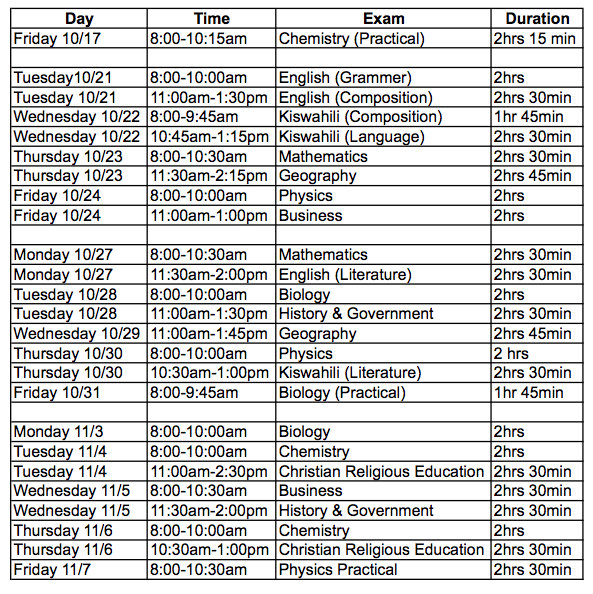“This test defines the life of a person after school in Kenya. That is unfortunately how the system here is designed. You can be exceptionally smart, but if you cannot perform on
What are the KCSEs, and why are they so important?
 KCSE stands for Kenya Certificate of Secondary Education, which is regulated by the Kenyan National Examinations Council. The KCSE is taken at the completion of Secondary school. Replacing the Kenya Advanced Certificate of Education (KACE), the KCSE debuted in 1989 as the new entrance requirement to attention a Kenyan university. The exam is taken by high school seniors.
KCSE stands for Kenya Certificate of Secondary Education, which is regulated by the Kenyan National Examinations Council. The KCSE is taken at the completion of Secondary school. Replacing the Kenya Advanced Certificate of Education (KACE), the KCSE debuted in 1989 as the new entrance requirement to attention a Kenyan university. The exam is taken by high school seniors.
In Kenya, students who manage a C- or higher qualify for college while students with a score B- or higher qualify for university. Since 2014, the Kenyan government has been supporting students who achieve a C- or above to either college or university through the Higher Education Loan Board.
Such scores are not easy feats. In 2013, 446,969 students took the exams, and only 36% scored at least a C+. Daraja students, however, have proven they are ready for the task as the 2012 and 2013 results have shown.
How long is the KCSE?
Three weeks. Check out Daraja’s exam schedule:
What subjects are covered?
There are seven subjects in total on the exam. The breakdown is as follows:

Three subjects are mandatory: English, Kiswahili, and Mathematics.
Two subjects must be from the sciences – Biology, Physics, and Chemistry.
One subject must come from the third group: History and Government, Geography, Christian Religious Education, Islam Religious Education, and Hindu Religious Education.
The seventh subject must come from any remaining subjects, or any of the following: Home Science, Art and Design, Agriculture, Woodwork, Metalwork, Building Construction, Power Mechanics, Electricity, Drawing and Design, Aviation Technology, Computer Studies, French, German, Arabic, Kenyan Sign Language, Music, or Business Studies.
What subjects are the girls choosing to take?
At Daraja, all Form 4s take the Chemistry, Business Studies, and Christian Religious Education (CRE) exams, and will also take the Geography or History exam and Biology or Physics exam, based on what they chose to study the past 2 years. 16 Form 4s will take Biology and 9 will take Physics, while 12 students will sit for History and 13 for Geography. This lineup will change, though, as next year’s Form 4s will also take Agriculture.
Who takes the KCSEs?
Form 4 students take the KCSE at the end of the school year. Like U.S. high schools, Kenyan secondary schools are comprised of four grades, or forms (Form 4s being seniors). So, Kenyan secondary students effectively spend four years preparing for these exams.
Where are the KCSEs taken?

KCSEs are taken at secondary schools that meet the requirements of holding the exams. The school must be registered with the Ministry of Education in order to qualify as an exam center. The Ministry comes and inspects the school to determine if it is adequate to serve as an exam center – some things they check for include laboratory space, enough classrooms to hold the number of students who will take the exam, and adequate washrooms, to name a few.
If a school is not deemed adequate to serve as an exam site, or if they do not have enough students to take the exam (a minimum of 15 is required), the school can send its students to another school where the exam is offered.
When are the KCSEs taken?
The KCSEs usually begin in October and continue through November. KCSE will officially begin on October 7 with oral exams, while Daraja students will begin their exams on October 17 and conclude on November 7.



Leave A Comment